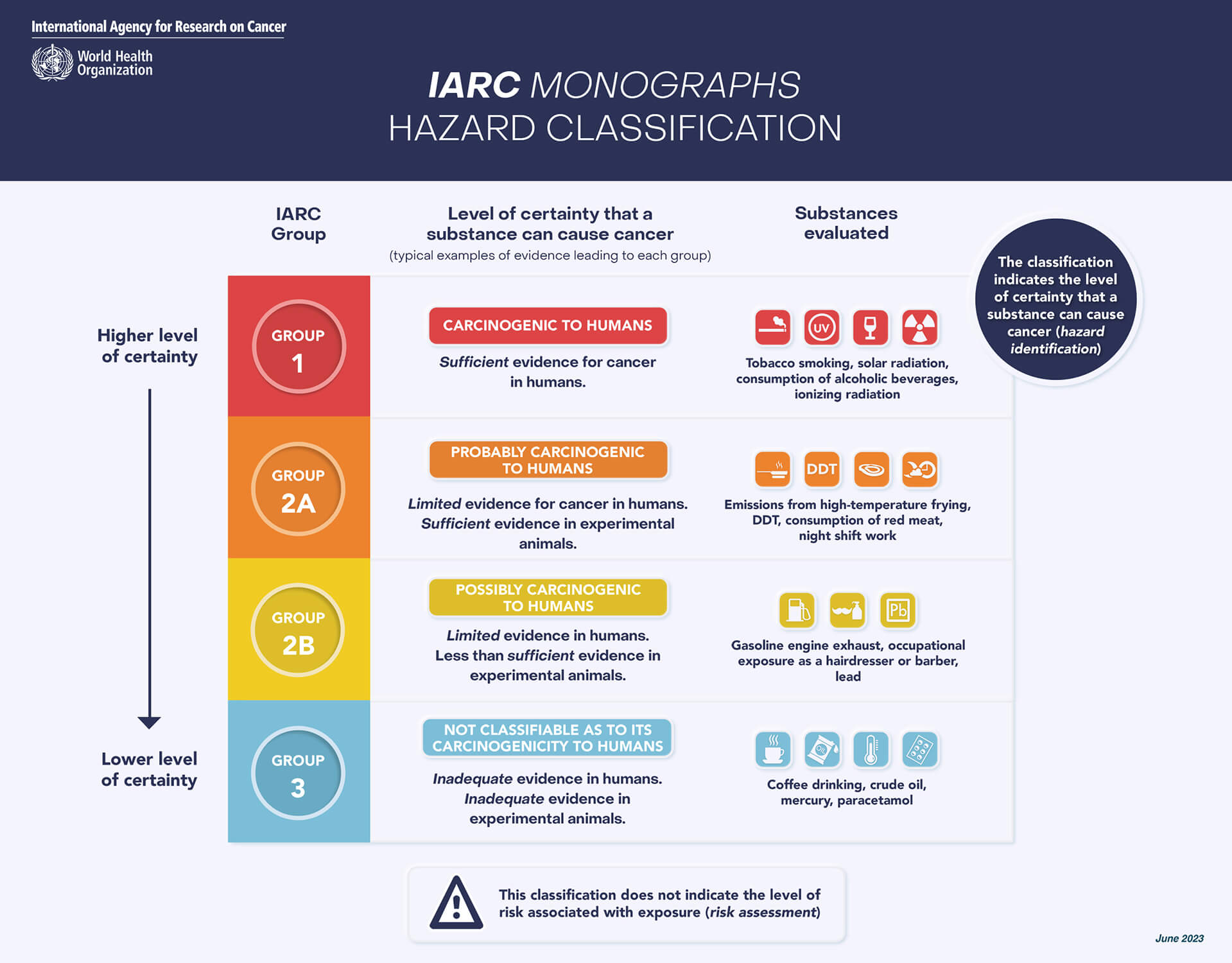Hazard classification of IARC
The International Agency for Research on Cancer (IARC) a specialised agency of the World Health Organisation (WHO) focuses on classifying agents regarding their carcinogenicity. To classify them, the agency publishes detailed studies (monographs) that assess the scientific evidence and its strength. In total, several hundred agents are evaluated by IARC, including tobacco, lead, coffee and UV radiation. These include electromagnetic fields, which are the subject of two separate assessments: one focusing on magnetic fields and the other on electric fields, both covering extremely low frequencies.
In 2019, the IARC updated its preamble – an introduction that explains the criteria and process used to assess the carcinogenicity of various substances and agents. In this preamble, an important precision is made by changing the name from : ‘IARC Monographs’ to ‘IARC Monographs on the Identification of Carcinogenic Hazard to Human’. This is an important precision, since there is a difference between ‘hazard’ and ‘risk’. In this new version, the evaluation focus on identifying ‘hazard’ which refers to the agent’s capacity to be carcinogenic, regardless of the level of exposure of the public or in occupational settings, while ‘risk’ arises when both a hazard and exposure to the agent are present.
Moreover, the classification groups were reduced from five to four. (group 1: Carcinogenic to human, group 2A: Probably carcinogenic to humans, group 2B: Possibly carcinogenic to humans and group 3: Not classifiable as to its carcinogenicity to humans); the group “not carcinogenic” is removed from the classification. Eventually, evaluation criteria have been revised on the basis of new evidence. For example, a greater importance is given to mechanistic evidence from in vitro studies. Mechanistic evidence refers to how the agent acts to cause the carcinogenic effects, for example at the molecular level, at the cellular level, etc.
1. Certainty of evidence
Cancers in humans?
Sufficient evidence:
- Causal association has been established
- Chance, bias, and confounding could be ruled out with reasonable confidence
Limited evidence:
- Causal interpretation is credible
- Chance, bias, or confounding could not be ruled out with reasonable confidence
Inadequate evidence:
- Studies permit no conclusion about a causal association
- Or no data are available
Evidence suggesting lack of carcinogenicity:
- Several high-quality studies covering the full range of exposure levels are mutually consistent in not showing an association at any observed level of exposure
- Bias and confounding were ruled out with reasonable confidence
- Conclusion is limited to the cancer sites, populations and life stages conditions and levels of exposure and length of observation covered by the available studies
Cancers in animals?
Sufficient evidence: Causal relationship has been established through either:
- Multiple results showing causal relationship (2 or more: species, studies, or sexes of Good Laboratory Practices study)
- Results of a single study when cancer occur to an unusual degree (incidence, site/type, age at onset, or multi-site)
Limited evidence:
- Data suggest a carcinogenic effect but are limited: e.g. from a single study, unresolved questions, benign tumours only, promoting activity only, etc.
Inadequate evidence:
- Studies permit no conclusion about a carcinogenic effect (major qualitative or quantitative limitations or no data available)
Evidence suggesting lack of carcinogenicity:
- Adequate studies involving both sexes of at least two species show that the agent is not carcinogenic
- Conclusion is limited to the species, tumour sites, age at exposure, and conditions and levels of exposure studied
2. Mechanistic evidence
Strong mechanistic evidence:
- The results obtained in different studies, examining the underlying biological processes, are consistent, showing that the available data are in agreement with each other
Limited mechanistic evidence (evidence is suggestive, but):
- Studies cover a narrow range of experiments, relevant end-points, and/or species
- Unexplained inconsistencies in the studies examining the underlying biological processes of similar design
- Unexplained incoherence across studies examining the underlying biological processes of different end-points or in different experimental systems
Inadequate mechanistic evidence:
- Few or no data are available
- Unresolved questions
- Available results are negative.
3. Overall classification:
The IARC classification is based on the certainty of the evidence and the mechanistic evidence as follows:
Group 1: Carcinogenic to human
- Sufficient evidence of carcinogenicity in humans
Group 2A: Probably carcinogenic to humans (at least two of the following evaluation + at least one involving exposed humans or human cells or tissues)
- Limited evidence of carcinogenicity in humans
- Sufficient evidence of carcinogenicity in experimental animals
- Strong evidence that the agent exhibits key characteristics of carcinogens (mechanistic evidence)
Group 2B: Possibly carcinogenic to humans (only one of the following conditions)
- Limited evidence of carcinogenicity in humans
- Sufficient evidence of carcinogenicity in experimental animals
- Strong evidence that the agent exhibits key characteristics of carcinogens (mechanistic evidence)
Group 3: Not classifiable as to its carcinogenicity to humans
- Inadequate evidence in humans
Inadequate evidence in experimental animals
© Copyright – International Agency for Research on Cancer (IARC), 2025. All Rights Reserved.
Source: https://www.iarc.who.int/infographics/iarc-monographs-classification/
Documents & Links
- IARC Monographs on the Identification of Carcinogenic Hazards to Humans – Preambule
- IARC Monographs hazard classification
- Agents Classified by the IARC Monographs, Volumes 1–136
- International Commission on Non-Ionizing Radiation Protection (ICNIRP): an independant international commission recognized by the World Health Organization (WHO)
Topics that might interest you ...
- Further information: https://www.bbemg.uliege.be/epidemiology/
- More information on epidemiologic studies bias in “Research methods” page.https://www.bbemg.uliege.be/epidemiology/
- Further information on current oucomes:
https://www.bbemg.uliege.be/emf-health-current-outcomes/



